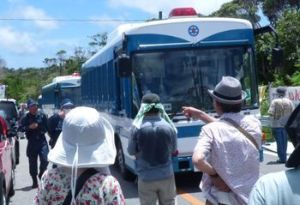Riot squad sent to subdue Takae protesters similar in scale to that sent to eradicate yakuza gangsters

A representative from the national government explains the resumption of construction work on land at Henoko at a meeting of a working group established by the Japanese national government and Okinawa prefectural government as part of an out-of-court settlement to the Henoko proxy execution lawsuit (July 14, Okinawa Prefectural Office)
July 18, 2016 Ryukyu Shimpo
By Ryota Nakamura
Approximately ten hours after the polls closed in the Upper House election, riot police formed a human wall in front of the main gate to the U.S. military’s Northern Training Area in Takae, Higashi Village, and materials relating to helipad construction started being carried in. After Liberal Democratic Party politicians lost every Diet seat representing Okinawa in both the upper and lower houses, the national government has started on a course of antagonizing Okinawans, jumping to push forward the construction of U.S. military facilities—construction from which it had been refraining in order to avoid repercussions in the election.
A leading government official explained the forceful resumption of construction, saying, “There is no problem with resuming construction. This just happens to be the timing at which we will progress.” He explained construction became possible after entering into July, after the end of the nesting period of the noguchigera woodpecker, a species designated by the Japanese government for special protection. However, he also revealed that the resumption of construction was delayed out of consideration for the Minister of State for Okinawa Affairs, Aiko Shimajiri, who was facing an uphill battle after anti-base sentiment swelled among Okinawans due to numerous incidents and accidents involving the U.S. military, including the rape and murder of a woman by a U.S. military contractor.

Chiba Prefectural Police riot squad vehicles pass by the gate to the training area while citizens protest the helipad construction (July 17, Takae Ward, Higashi Village, in front of the N1 zone gate to the U.S. miltary’s Northern Training Area)
In March of this year, after the national and prefectural governments agreed to a settlement in the Henoko relocation proxy execution lawsuit, the national government suspended construction at Henoko and put on a conciliatory face with an eye toward the Upper House election. In Takae, from March until June, it looked like the helipad construction had come to a standstill for the nesting period of the birds inhabiting the area.
However, behind the scenes, preparation was being carried out for the construction. Anticipating protests by citizens opposed to the construction, the government prepared to gather approximately five hundred riot squad personnel from the Tokyo Metropolitan Police Department and other police departments around the country to send to the construction scene.
Meanwhile, on June 23, the day after campaigning started for the Upper House election, the Ministry of Defense notified approximately sixty employees of their own ministry and local defense bureaus that they were to be stationed in Takae and Henoko as “security personnel” in response to protests at the two sites. The employees were also part of an “Okinawa/regional safety patrol unit” established to prevent recurring crimes after the murder incident by a U.S. military contractor, and were additionally assigned as security personnel.
The government plans to send a total of 560 security personnel to the sites of the protests. Regarding the fact that these preparations were made behind closed doors while the Upper House election was going on, a Ministry of Defense official revealed, “We weren’t facing an uphill battle—more like a typhoon. There was no question as to who would win [the Upper House election].”
Meanwhile, some people associated with the police and defense express a different view. One source involved in security grimaced as he referenced measures taken in 2014 to eradicate Kudo-kai, a registered dangerous yakuza group, in which 530 additional riot squad personnel were sent to the front lines. “These security efforts are the same scale as were used to eradicate the Kudo-kai. It is not normal to view gangsters with heavy weapons and ordinary citizens in the same light,” he said, expressing doubt toward the fact that the national government is taking the same confrontational stance toward ordinary citizens as it did toward dangerous gangsters.
After Shimajiri lost the Upper House election, politicians opposed to the Henoko base construction and backed by the “All-Okinawa” faction working with Governor Takeshi Onaga came to fill all six seats representing Okinawan electoral districts in both houses of the national Diet. Nonetheless, the government is barreling forward aggressively; as early as July 22, it plans to resume construction on land at Henoko and on the Takae helipads, and simultaneously plans to move forward with a new lawsuit against the Okinawan governor.
A member of All-Okinawa Kaigi (All-Okinawa Coalition) observes that the national government got a head start on Governor Onaga, who plans to call for a reduction of the base burden on Okinawa at a nation-wide meeting of governors on July 28 and 29. “They probably want to make a show of proclaiming that the governor is incapable of preventing the construction,” he said, expressing strong distrust and vigilance toward the national government.
(English translation by T&CT and Sandi Aritza)
Previous Article:Governors establish council body for nationwide discussion of Okinawa base burden reduction
Next Article:Okinawa governor condemns helipad construction in Takae
[Similar Articles]
- Tensions between protesters and riot police mount over construction of U.S. Marine Corps helipads in Takae
- Okinawa governor condemns helipad construction in Takae
- Sit-in protestors claim fight against Takae construction is ongoing
- Government to set up a special team at Okinawa’s police headquarters to tighten security for Henoko
- Tokyo riot police join security at Camp Schwab; protester arrested in scuffle
 Webcam(Kokusai Street)
Webcam(Kokusai Street)


